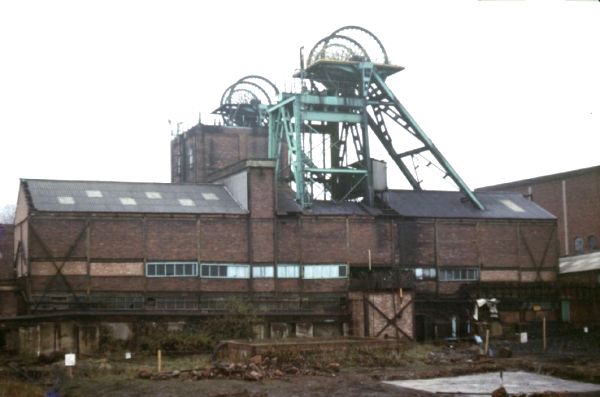
Cronton Colliery 1984
Used with kind permission of Simonrail
The Hulton Colliery Co. Ltd began sinking this colliery in 1913 and worked it until it was Nationalised in 1947. It was linked to the railway network by a mineral branch, which had earlier served Whiston and Halsnead collieries. This joined the LMS railway near the Huyton Quarry Junction with the LMSR’s Huyton & St Helens Line. The coal winding shaft was completed to a depth of 475 metres in 1916, and intersected the Plodder, Wigan Four Feet, Lower Florida, Pigeon House and Rushy Park Seams, which were all worked.
An explosion in the Pasture, or Crombouke, seam on December 11th 1917 killed eight men. The seam, which was reached by means of rise tunnels from the Florida Seam, had opened for about nine months. It was being developed on the bord and pillar system, but at the time of the accident there were only three stalls, and only them was being worked. The ventilation was adequate, with 5,400 cubic feet per minute flowing. The stalls were 15 yards wide, packed solid against the coal on the dip side and had an air road left against the coal on the rise side. There was 12 to 15 yards of solid coal between the stalls which were driven for 25 yards. The holing in stalls 301 and 302 was done by coal cutting machines worked by compressed air. The explosion occurred at the face of stall 301 where two Monobel No.1 shots were fired in the coal by an electric battery.
After the explosion it was found that a seam, nine feet thick, existed seven and a half feet above the Pasture Seam. This seam was not encountered during the sinkings owing to the ground being faulted. The ground between the seams consisted of clod and thin bands of coal which sagged down considerably on the roads and at the faces of the stalls. The top seam no doubt gave off a large amount of gas which collected in the space between the seams. A large fall of ground appeared to have happened immediately before two shots were fired, and they ignited the gas released. The full report can be found here.
In 1966 Cronton pioneered the use of retreat mining, a technique which was widely used on the continent, at a British Colliery. This doubled the colliery’s production. This involved driving parallel roadways to the proposed extent of working, and then the face was driven between them. Coal was then worked coming outbye, as opposed to going inbye which was normal. While this system involved major expenditure in driving the gates before any coal was removed, it had the advantage of identifying unexpected faults, seam thinning etc. It also removed the need for ripping, and left the goaf behind, reducing the risk of heatings. Cronton is thought to be the first British colliery to adopt full retreat mining.
The seams worked at Cronton were:
| 1915-1955 | Higher Florida |
| 1915-1965 | Lower Florida (Pemberton Four Feet) |
| 1917-1920, 1930 | Earthy Delf |
| 1920-1930, 1940-1955 | Yard |
| 1920-1930, 1950 | Felcroft |
| 1925-1940, 1964-1965 | Rushy Park |
| 1930 | Prescot Main Delph |
| 1935 | Cheshire |
| 1940, 1955, 1975 | Crombouke (Pasture) |
| 1930, 1947-1950 | Queen (Burghy) |
| 1947, 1952, 1965-1970 | Wigan Four Feet |
| 1950 | Ravenhead |
| 1950-1970 | Plodder |
| 1952-1961 | Haigh Yard |
| 1960-1965 | Pigeon House |
| 1960, 1975-1984 | London Delph |
During the period 1960 to 1980 Cronton’s workforce fell from 901 to 460 underground. On the surface it fell from 252 to 122. The principal markets for its coal, which came from the London Delf after 1975, were the CEGB and the general industry of the area.
Cronton was placed in review by the NCB in November 1983, and closed in March 1984.
OUTPUT AND PRODUCTIVITY FIGURES
| OUTPUT (tons) | OUTPUT PER MANSHIFT (cwt) |
MANPOWER | |
|---|---|---|---|
| 1970/71 | 355,913 | 45.8 | 653 |
| 1971/72 | 257,209 | 37.6 | 670 |
| 1972/73 | 225,234 | 32.0 | 625 |
| 1973/74 | 157,990 | 28.0 | 601 |
| 1974/75 | 229,994 | 36.7 | 616 |
| 1975/76 | 249,562 | 39.4 | 607 |
| 1976/77 | 240,038 | 39.1 | 584 |
| 1977/78 | 270,014 | 42.9 | 591 |
| 1978/79 | 256,721 tonnes | 1.97 tonnes | 583 |
| 1979/80 | 185,494 tonnes | 1.45 tonnes | 582 |
| 1980/81 | 298,500 tonnes | 2.35 tonnes | 572 |
Further information:
- NMRS Records, Gazetteer of British Collieries.
- Colliery Profile: Cronton Colliery, Public Relation Department NCB April 1981
- Coal News, November 1983, p.7 – in review

